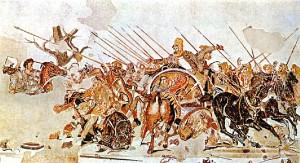Hellenism as Cultural Phenomenon
 Excerpted from Lawrence H. Schiffman, From Text to Tradition- A History of Second Temple & Rabbinic Judaism, Ktav Publishing House, Hoboken, NJ, 1991.
Excerpted from Lawrence H. Schiffman, From Text to Tradition- A History of Second Temple & Rabbinic Judaism, Ktav Publishing House, Hoboken, NJ, 1991.
The cultural phenomenon that we call Hellenism had a lasting impact on Judaism and the Jewish people. Hellenism was a synthesis of Greek (Hellenic) culture with the native cultures of the Near East. It was a dynamic phenomenon, with the ever-evolving Hellenistic (“Greek-like”) culture continually becoming the raw material for new syntheses with other native cultures not yet under its sway. Indeed, it was not the Greeks themselves, but the Macedonians, whose civilization was derivative from that of the true Hellenes, who were mainly responsible for spreading Greek culture to the Near East. As Hellenism penetrated each new region, an amalgamation of the Hellenistic with the native took place, and this phenomenon resulted in the many different manifestations of Hellenistic culture observable in the Near East over many centuries.
It was Alexander’s conquests that made possible the fateful union between East and West, but in fact there were deeper cultural reasons for the ease with which these two civilizations entered into a symbiotic relationship. Greek culture had by this time developed to its pinnacle. It had been liberated from the limitations of geography, and one could now be a Hellene by education and culture, not just by birth. Humanism had resulted from the primacy attributed to reason in Greek thought. Man now was at the center of the cosmos rather than merely of the polis (the Greek city) as he had been earlier. Concurrently, the native Near Eastern civilizations had run their course and were on the decline. Egypt and Mesopotamia apparently produced little of literary or intellectual import in this period, and the widespread interest in new religions observable in the sources indicates a hunger for new means of spiritual fulfillment. The time was ripe for a new cultural movement. Thus the peoples of the defeated Persian Empire could offer no more resistance to the Hellenic cultural onslaught than they had to the Macedonian army.
The Greek city, known as the polis, was the vehicle for the assimilation and Hellenization of the indigenous peoples of the Near East. Newly founded Greek cities, populated mostly by local people, were the cultural melting-pots of the East. The institutions of the Greek way of life were opened to all who wished to participate. The Greek language was rapidly adopted as a sign of Hellenization. People from the surrounding areas, streaming into the cities, quickly gained the legal and economic advantages afforded by citizenship in the po1is—exemption from certain customs and duties and participation in the municipal government. In the Greek cities the upper classes of the Near East were acculturated through the schools and other institutions of the Hellenistic world.
Most interestingly, the native Near Easterners gravitated as well to the Hellenic arts and sciences and soon took the lead in such disciplines as literature and philosophy. The Greek emphasis on physical culture and on beauty also spread throughout the Near East. The religion of the Greeks was fused with that of the natives in many different forms and local cults. All of this was abetted by the polis and its official city cult, in which the Greek and the Near Eastern were in constant symbiosis.
Yet the indigenous peoples did not simply absorb the Hellenic and the Hellenistic; they redefined and reinterpreted their own traditional cultures in light of the “modern” civilization in which they now found themselves. The process of reinterpretation led to the several varieties of Hellenistic Judaism. Before taking these up, in particular as they relate to Palestinian Judaism, a brief survey of political developments during this period is in order, for they set the stage for the struggle over the extent of accommodation to Hellenism that would soon engulf the Jewish homeland.



